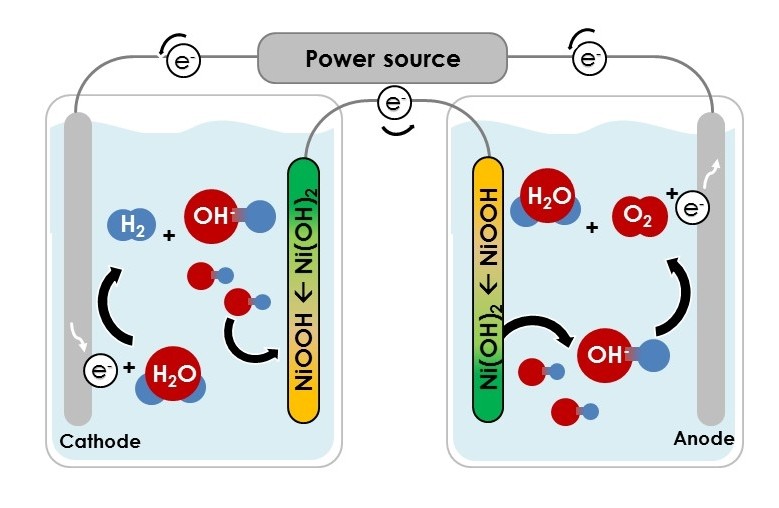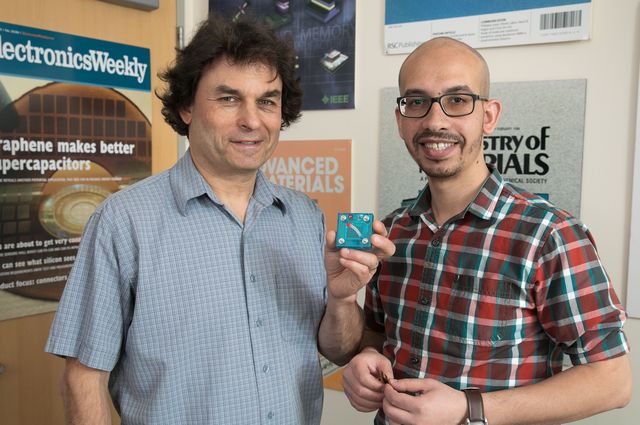Technion is an interdisciplinary technology institution based in Haifa, Israel. Two years ago, it began promoting its unique approach to splitting water to extract hydrogen. One of the researchers on the project won a three-minute thesis contest with her quick and eloquent explanation of photoelectric chemical water splitting, key to the research team’s approach. Point of Sale Delivery The Jerusalem Post reported, “Technion-Israel Institute of Technology researchers have developed a new method for the production of hydrogen from water that uses solar energy in a centralized way at the point of sale, such as a gasoline station for electric cars fueled by the gas.” (Editor’s italics) The article explained, “This eliminates the need for ‘solar farms’ whose hydrogen has to be trucked a long distance, making the process cost effective, safe and efficient.” Published two years ago in Nature Materials, the study was led by Avigail Landman, a doctoral student in the Nancy & Stephen Grand Technion Energy Program and …
Three-in-One Device Stores Energy, Makes Hydrogen
UCLA researchers Richard Kaner and Maher El-Kady, “Have designed a device that can use solar energy to inexpensively and efficiently create and store energy, which could be used to power electronic devices, and to create hydrogen fuel for eco-friendly cars.” Kaner and El-Kady have devised many low-budget approaches to capturing and exploiting energy, such as their method of “burning” supercapacitors on a personal computer DVD. Their newest accomplishment, according to Kaner, “Could dramatically lower the cost of hydrogen cars.” It would be useful in urban or rural areas, or even on remote battlefields, giving users the ability to make both electricity and fuel from the same device. In cities, it could store surplus energy from electrical grids, and in more remote locations, allow energy generation and fuel creation “off the grid.” The pair’s replica of the device looks like a designer electronic gizmo encased in a turquoise plastic case. It uses inexpensive, abundant elements like nickel, iron and cobalt to …
Full-Spectrum Solar-Generated Hydrogen
Osaka University researchers have created a new material based on gold and black phosphorus to produce clean hydrogen fuel using the full spectrum of sunlight. Most solar apparatus used in “water splitting” rely on materials such as titanium dioxide. These are limited to obtaining energy from the ultraviolet (UV) part of the solar spectrum, however. The rest of the spectrum is wasted. Osaka’s team “developed a material to harvest a broader spectrum of sunlight,” using a three-part composite. The different parts maximize absorption of light and enhance the efficiency of the unit for water splitting. The core, a “traditional” semiconductor of lanthanum titanium oxide (LTO) is coated with tiny nanoparticle specks of gold. The gold-covered LTO is then mixed with ultrathin sheets of black phosphorus (BP), which acts as a light absorber. Bonding the gold-coated LTO to the BP layer makes a serendipitous combination. Team leader Tetsuro Majima says. “BP is a wonderful material for solar applications because we can …
Making Hydrogen Abundant and Inexpensive
The quandary in producing and using hydrogen is that it’s the most common element in the universe and the oldest, having been formed within a micro-second of the Big Bang. Despite that, it’s always associated with other materials, and to use pure hydrogen usually requires extracting from the material in which it’s found. Water is the most common source for hydrogen, but as noted before, getting hydrogen out of water is harder than it looks. As shown in earlier blog, various techniques have been tried to make this extraction, some seemingly close to providing usable quantities at reasonable prices. Dr. Daniel Nocera of MIT and later Harvard used a two-catalyst system to pull oxygen and hydrogen from water. State University of New York at Buffalo researchers dropped nano-sized particles of silicon in water, with resulting bubbles of hydrogen escaping in large enough quantities to power portable devices. Although the Alka-Seltzer-like reaction seems to have promise, Elena Rozhkova, a scientist at …
Taking That Fork in the Solar Road
Kyoung-Shin Choi, a chemistry professor at the University of Wisconsin-Madison, and postdoctoral researcher Tae Woo Kim combined forces to come up with a two-pronged approach for producing stored energy from mere sunlight. Many researchers take the familiar path of using expensive materials to extract the greatest percentage of energy from solar cells, but others use low-cost, less efficient organic materials spread across a greater area to get the same results. Choi and Kim, though, decided that selecting two different low-cost materials could give greater results – something a more single-path approach would miss. As their U of W report states, “Generating electricity is not the only way to turn sunlight into energy we can use on demand. The sun can also drive reactions to create chemical fuels, such as hydrogen, that can in turn power cars, trucks and trains.” The expensive semiconductors and catalysts normally used to transform sunlight to fuels are “far too expensive” to make competitive sun fuel possible, …
Rust and Sunshine Do Mix
Chemists at Boston College in Chestnut Hill, Massachusetts, “Have achieved a series of breakthroughs in their efforts to develop an economical means of harnessing artificial photosynthesis by narrowing the voltage gap between the two crucial processes of oxidation and reduction, according to their paper, “Hematite-Based Water Splitting with Low Turn-on Voltage,” published this week in the journal Angewandte Chemie.” With your editor wishing he’d paid more attention in high-school chemistry, a quick search came up with simple definitions of oxidation and reduction. Oxidation is gain of oxygen. Reduction is loss of oxygen. When reduction and oxidation take place simultaneously, this is known as a redox reaction. These types of reactions take place in leaves producing plant energy from sunlight, and researchers are closing in on duplicating the reactions at a level which will make artificial photosynthesis an inexpensive, practical way to collect and store energy. So far, they’ve managed to produce 80 percent of the necessary voltage levels from their unique photoanodes and photocathodes. …
Solar Cells and Artificial Photosynthesis Make Hydrogen Directly
Science 2.0.com reports on an exciting potential breakthrough in solar energy and its direct transformation into hydrogen fuel. Usually, solar cells generate current from photons, making electricity which can run things or be stored in batteries. This new and different approach, using an innovative and inexpensive solar cell and a metal oxide photo anode, can store nearly five percent of solar energy chemically as hydrogen. The metal oxide bismuth vanadate (BiVO4) photo anode includes a small dose of tungsten atoms, was then sprayed onto conducting glass and “coated with an inexpensive cobalt phosphate catalyst,” which helped speed up oxygen formation during water splitting. Science 2.0 reports Professor Dr. Roel van de Krol’s remarks. He’s head of the Helmholtz Zentrum Berlin Institute for Solar Fuels, and worked with researchers there and at Deflt University. “Basically, we combined the best of both worlds. We start with a chemically stable, low cost metal oxide, add a really good but sim ple silicon-based thin …
Salt Plus Titanium Dioxide Plus Light Equals Hydrogen
Microorganisms found in salt flats could offer a new path to green hydrogen fuel, according to researchers at the U.S. Department of Energy’s Argonne National Laboratory. Argonne researchers say that some desert salt flats shelter “a protein found in the membranes of ancient microorganisms,” and could hold promise for generating hydrogen fuel in an “environmentally friendly” way. Salts come in a variety of colors, and each edible variety can lend a unique taste to recipes, but the purple salt used in the Argonne experiments can help make hydrogen. Elena Rozhkova is a scientist at Argonne’s Center for Nanoscale Materials in the Nanoscience and Technology Division. She develops her own research programs and works with users in the Center for Nanoscale Materials (CNM), where her work, “Intensely overlaps different kinds of sciences: materials science, chemistry, physics and biological sciences.” Her research develops nanobio hybrid materials, combining “inorganic nanomaterial and a soft biological material and combin[ing] them in hybrid structures with advanced …
Soy Beans – Not Just for Tofu Anymore
Shilpa and twin sister Shweta Iyer have been working on splitting water to extract hydrogen for many years. In November, 2012 the Port Jefferson Station high school students won regional finalist honors in the Siemens Competition in Math, Science & Technology, and netted $1,000 each. They were awarded the Grand Prize in the Long Island Science and Engineering Fair in March, and were sent to Phoenix, Arizona in May to compete in the Intel International Science and Engineering Fair, where they won fourth place and $500 each. Their winnings go into college funds which they will invest in the fall. What has won these young women international recognition? Perhaps it’s their work in creating a catalyst for the production of hydrogen – from literally dirt cheap material that advisor James Muckerman credits with being, “the best performing, non-noble-metal-containing hydrogen evolution catalyst yet known – and even better than bulk platinum metal.” The young women entered the U. S. Department of …



